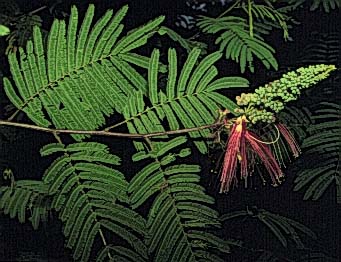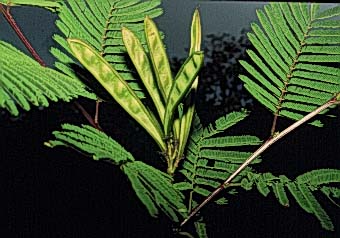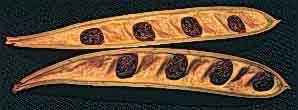
Calliandra callothyrsus
Meisner, Linnaea 21: 251. 1848
(Fabaceae)
|
Calliandra callothyrsus Meisner, Linnaea 21: 251. 1848 (Fabaceae) | |
Espinoza, R., Perez, D., Masís, A., Guadamuz, A. and Chavarría, F. 1998. Calliandra callothyrsus (Fabaceae) Species Page, 24 February 1998. Species Home Pages, Area de Conservación Guanacaste, Costa Rica. http://www.acguanacaste.ac.cr
I. Identification:
Tree or shrub up to 1-3 m tall (Zamora 1991).
Flower:
The most conspicuous flower characterisitic are its many red exerted stamens. The calix is light green and the corolla is lighter green. The pistil is white.
Inflorescence and inmature fruit | |
The inflorescence is a panicle of flowers arranged in umbels with the peduncle up to 1 cm in length (Zamora 1991). Many flowers per inflorescence. The flowers open from the base of the panicle upwards during its flowering period.
The flowers has a "bean" odor. When the flower is cut it turns purple and then brown.
The flower buds are elliptical. The inferior area is light green and the apex of the bud is purplish.
Fruit:
The legumes are dihiscent, spliting up in two parts from the apex to the base (Zamora 1991); has between 4-6 seeds per fruit. They are light green while inmature.
 | |
Inmature fruits | |
 |
 |
Open fruits (green and mature) | |
Leaves:
The leaves are bippinately compound, each leaf having around 9-15 pairs of pinnas and in turn each having around 80-100 pinnulas.
|
Upper side |
Under side |
|
Leaf arrangement |
Leaflet arrangement |
|
Leaflets | |
It has 2 linnear and persistant stipules.
|
Stipule |
Bark and wood:
The bark is light brow and smooth. The outer wood is cream color and the heartwood is white.
Whole plant architecture:
Similar species:
Verification:
The old names for this species are Calliandra confusa Sprague & Riley. Inform. 1923: 371. 1923. Calliandra similis Sprague & Riley, Bull. Misc. Inform. 1923: 372. 1923. (Zamora 1991).
II. Geographic distribution:
International:
Mexico to South America (Zamora 1991).
In Costa Rica
In the Area de Conservación Guanacaste:
Mapa de macro-habitats del ACG |
III. Natural history:
IV. How to find:
There are several individuals on the humid parts of the ACG along the first 100 m on the road to Estación Bilógica Pitilla..
Acknowledgments:
This project was carried out by the Area de Conservación Guanacaste/CR, with help from INBio/CR, ICBG from the Foggarty center, NIH/USA and NSF/USA.
Literature cited:
Zamora, N. 1991. Tratamiento de la familia Mimosaceae (Fabales) de Costa Rica.
Brenesia 36:63 - 149.